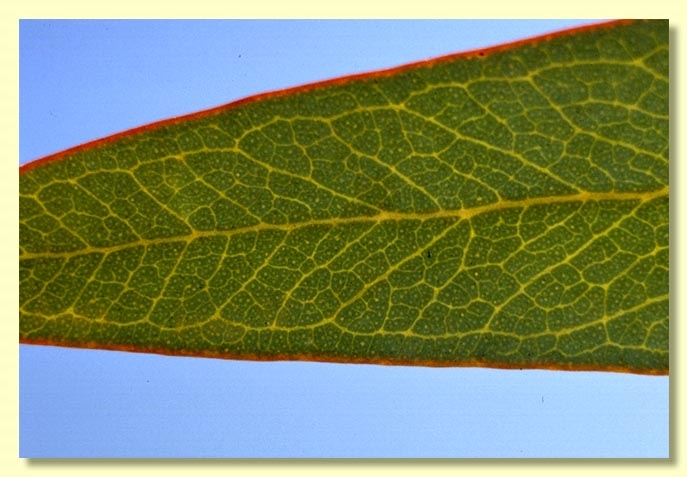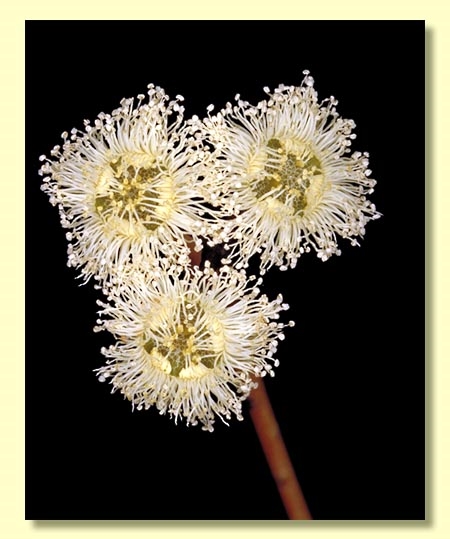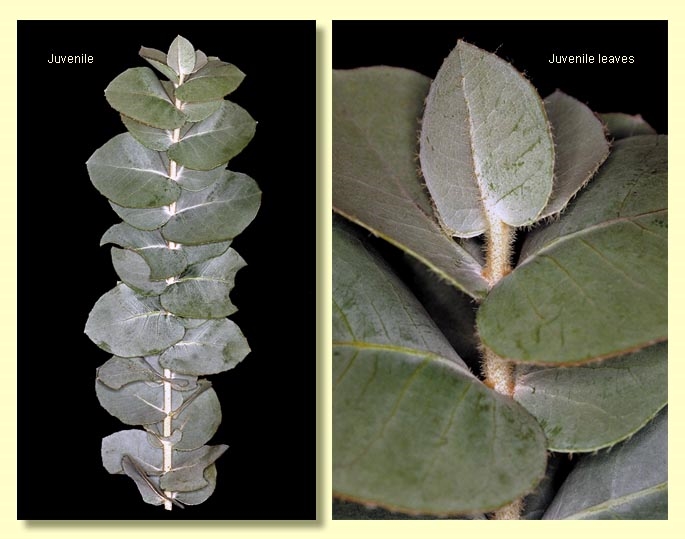Euclid - Online edition
Eucalyptus gongylocarpa
Eucalyptus | Eudesmia | Limbatae | Edentatae | Acetabuliformes
T: Western Australia: Camp 60, near Queen Victoria Spring, 24 Sept. 1891, R.Helms s.n.; holo: NSW [specimen cannot be found, fide Telopea 7 (4) 382 (1998)].
Bark usually smooth throughout, white to pale grey; sometimes with yellow-brown to red-brown flaky scaly rough bark.
Branchlets usually glaucous; always with oil glands in the pith.
Juvenile growth (coppice or field seedlings to 50 cm): stems rounded in cross-section, glaucous with stellate hairs; juvenile leaves opposite and sessile, orbicular to ovate to cordate, sometimes with irregular or crenate margins, 2.5–5 cm long, 2–5.5 cm wide, base amplexicaul, glaucous, usually with hairs.
Adult leaves opposite to sub-opposite, petioles 0.3–1.4 cm long; blade lanceolate to elliptical, 3–8 cm long, 0.8–1.8 cm wide, base tapering to petiole, concolorous, dull grey-green to blue-grey, usually glaucous, side-veins acute, tertiary venation sparse to moderate, intramarginal vein present, oil glands mostly island.
Inflorescence axillary, peduncles 0.8–1.9 cm long, buds usually 7 (occasionally 3) per umbel, pedicellate (pedicels 0.3–0.6 cm long). Mature buds clavate (0.5–0.6 cm long, 0.3–0.5 cm wide), glaucous, outer perianth whorl minutely sepaline (often very difficult to see), inner whorl operculate, operculum rounded, stamens seemingly grouped in four clusters but close inspection shows stamens borne on a continuous staminophore, inflexed, anthers oblong, versatile, dorsifixed, dehiscing by longitudinal slits (non-confluent), style short, stigma tapering, locules usually 4, the ovules arranged in 4 distinct vertical rows on the placentae. Flowers whitish.
Fruit pedicellate (pedicels 0.3–0.7 cm long), globular, 0.6–1.1 cm long, 0.6–1.2 cm wide, usually glaucous, particularly around the disc, disc vertically descending, valves 4, small, enclosed.
Seeds black, flattened, saucer-shaped with a narrow flange around the edge, 2–3 mm long, surface smooth, hilum ventral.
Cultivated seedlings (measured at node 10): cotyledons reniform; stems round in cross-section, hairy, leaves usually sessile, rarely shortly petiolate, opposite to sub-opposite, orbicular to ovate to cordate, 2.3–6 cm long, 1.8–5 cm wide, glaucous, margins entire or irregularly crenate, apex broadly acute to rounded, base amplexicaul to lobed or rounded to truncate, lamina hairy on the margins, midrib and main lateral veins.
Flowering has been recorded in January and July.
A tree widespread in desert parts of Western Australia from west of Sandstone to north-west South Australia and south-west central Australia. The bark is normally smooth and strikingly white although often spotted or occasionally with yellow-brown to red-brown loose flakes of rough bark. The branchlets, leaves, buds and fruit are glaucous, the adult leaves being small, dull, with round oil glands.
Eucalyptus gongylocarpa belongs to the taxonomically complex subgenus Eudesmia and is included in the section Limbatae, series Edentatae, subseries Acetabuliformes because of the combination of cotyledons reniform in shape and folded and clasping in embryo, seedlings stellate hairy, buds with very small inconspicuous calyx lobes on the midline of the bud which do not persist onto the rim of the fruit and stamens arranged in four bundles. It is placed in the subseries Acetabuliformes on its own as it is not closely related to any other species.
The shorter adult leaves, the narrower, glaucous fruit and the saucer-shaped seeds distinguish E. gongylocarpa from E. jucunda, the only other species in the series Edentatae.















